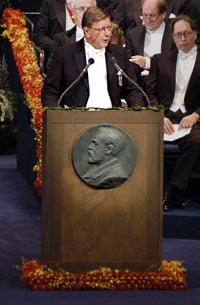Award ceremony speech
Presentation Speech by Professor Hans Ringertz of the Nobel Assembly at Karolinska Institutet, December 10, 2003.

Copyright © Nobel Media AB 2003
Photo: Hans Mehlin
Your Majesties, Your Royal Highnesses, Honoured Nobel Laureates, Ladies and Gentlemen,
To be able to visualize the inner organs of humans without invasive techniques is of paramount importance to modern medicine. Medical imaging has undergone a dramatic development during the last 30 years. A whole series of imaging modalities have been discovered and developed, among which the development of computer assisted tomography was awarded a Nobel Prize in Physiology or Medicine in 1979. Magnetic Resonance Imaging, MRI, represents a new modality for obtaining diagnostic medical images. The technique still has extensive potential for further development but MRI is important to monitor many diseases of most organs in the human body. Imaging with magnetic resonance is an invaluable aid in the whole healthcare chain from screening and detection, diagnosis and treatment, to follow up of diseases.
Felix Block and Edward Mills Purcell first demonstrated the physical phenomenon of nuclear magnetic resonance in 1946. These discoveries were awarded a Nobel Prize in Physics in 1952. Magnetic resonance occurs in magnetic fields between atomic nuclei and electromagnetic waves of radio frequencies. Atomic nuclei have a magnetic moment and in the magnetic field, their spin depends on the strength of the field. The direction of magnetization resulting from the magnetic moments can change. This happens when the nuclei are in resonance with radio waves of the same frequency as the frequency of their own rotation. In the same way the nuclei can send back radio waves, when there is a change in the direction of the magnetic moment.
Initially, magnetic resonance was mostly used for spectroscopy, to study structures of chemical compounds. In the early 1970s Paul Lauterbur discovered the possibility to create a two-dimensional image by introducing gradients in the magnetic field. By analysis of the characteristics of the emitted radio waves, he was able to determine their origin. This made it possible to build up images of structures that could not be visualized with other methods.
Peter Mansfield discovered further possibilities to utilize gradients in the magnetic field. He showed how the radio signals could be mathematically analysed, which made it possible to develop a useful imaging technique. Mansfield also showed how images could be achievable extremely fast using magnetic resonance. This became technically possible in clinical medicine about a decade later.
Using a metaphor, magnetic resonance spectroscopy is like listening to a radio broadcast of a symphony in the 1940s. Imaging would then be like sitting in a concert hall listening to the symphony, and not only hearing but also seeing the instruments, how they play and where they are located, like organs in the human body. And when you hear the violins, you can even recognise, as in a magnetic resonance image, a false note like a disease process in that body.
Professor Lauterbur and Professor Mansfield,
Your discoveries of imaging with magnetic resonance have played a seminal role in the development of one of the most useful imaging modality in medicine today. All indications are that it will be even more important in the future of both medical practice and research, and, above all for the patient.
On behalf of the Nobel Assembly at Karolinska Institutet, I wish to convey to you our warmest congratulations, and I now ask you to step forward to receive the Nobel Prize from the hands of His Majesty the King.
Nobel Prizes and laureates
Six prizes were awarded for achievements that have conferred the greatest benefit to humankind. The 14 laureates' work and discoveries range from quantum tunnelling to promoting democratic rights.
See them all presented here.
